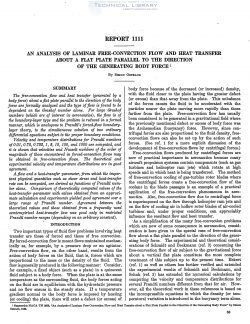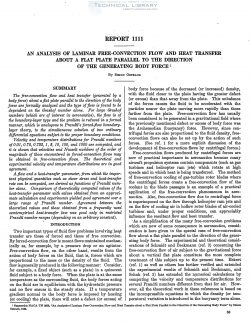naca-report-1111

- Version
- 185 Downloads
- 1.84 MB File Size
- 1 File Count
- September 7, 2016 Create Date
- September 7, 2016 Last Updated
National Advisory Committee for Aeronautics, Report - An Analysis of Laminar Free Convection Flow and Heat Transfer about a Flat Plate Parallel to the Direction of the Generating Body Force

The free-convection flow and heat transfer (generated by a
body force) about a flat plate parallel to the direction of the body
force are formally analyzed and the type of flow is found to be
dependent on the Grashof number alone. For large Grashof
numbers (which are of interest in aeronautics), the flow is of
the boundary-layer type and the problem is reduced in a formal
manner, which is analogous to Prandtl’s forced-fimv boundary-
layer theory, to the simultaneous solution of two ordinary
difi'erential equations subject to the proper boundary conditions.
Velocity and temperature distributions for Prandtl numbers
of 0.01, 0.72, 0.733, 1, .9, 10, 100, and 1000 are computed, and
it is shown that velocities and Nusselt numbers of the order of
magnitude of those encountered in forced-convectionfiows may
be obtained in free-convection flows. The theoretical and
experimental velocity and temperature distributions are in good
agreement.
A flow and a heat-transfer parameter, from which the impor-
tant physical quantities such as shear stress and heat-transfer
rate can be computed, are derived as functions of Prandtl num-
ber alone. Comparison of theoretically computed values of the
heat-transfer parameter with values obtained from an approxi-
mate calculation and experiments yielded good agreement over a
large range of Prandtl number. Agreement between the
theoretical values and those obtained from a frequently used
semiempirical heat-transfer law was good only in restricted
Prandtl number ranges (depending on an arbitrary constant).
Two important types of fluid flow problems involving heat
transfer are those of forced and those of free convection.
By forced-convection flow is meant flows maintained mechan-
ically as, for example, by a pressure drop or an agitator.
Free-convection flow, on the other hand, results from the
action of body forces on the fluid, that is, forces which are
proportional to the mass or the density of the fluid. The
flow is generally produced in the following manner: Consider,
for example, a fixed object (such as a plate) in a quiescent
fluid subject to a body force. When the plate is at the same
temperature as the surrounding fluid, the body forces acting
on the fluid are in equilibrium with the hydrostatic pressure
and no flow ensues in the steady state.
| File | Action |
|---|---|
| naca-report-1111 An Analysis of Laminar Free Convection Flow and Heat Transfer about a Flat Plate Parallel to the Direction of the Generating Body Force.pdf | Download |

Comment On This Post